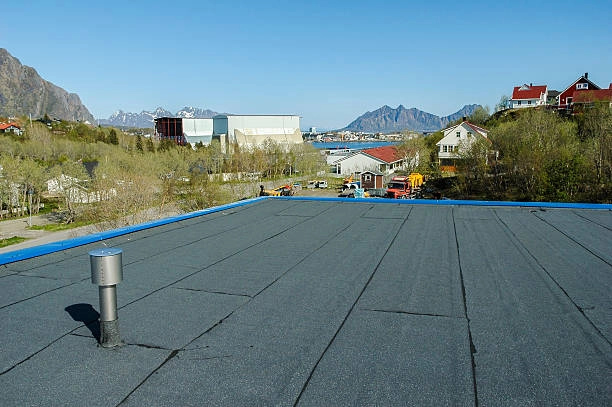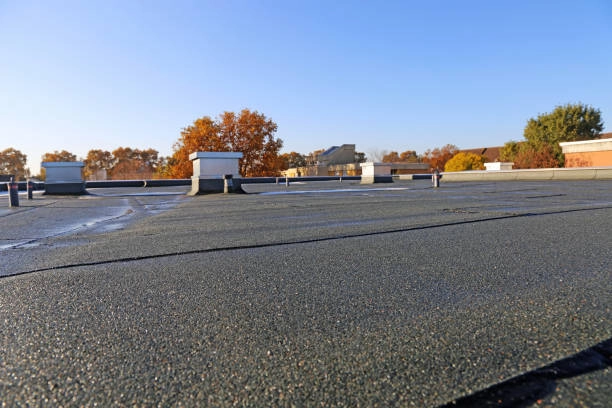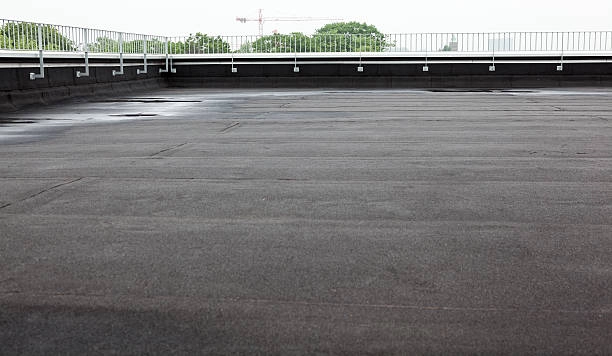When it comes to flat roof replacement, selecting the right materials is crucial for ensuring the longevity, durability, and performance of your roof. With various options available, it’s important to understand the pros and cons of each material to make an informed decision. This guide will help you navigate through the process of choosing the best materials for your roof replacement.

Understanding Flat Roofing Materials
There are several popular materials used for flat roof replacement, each with its own set of characteristics:
Thermoplastic Polyolefin (TPO)
TPO has become a top choice for flat roof replacements due to its exceptional performance and cost-efficiency. It offers:
- High durability and UV resistance
- Energy efficiency, reflecting heat, and reducing cooling costs
- Easy installation, saving time and labor costs
- Availability in various thicknesses and widths
TPO is particularly suitable for buildings that require high reflectivity, such as school buildings, offices, and malls.
Ethylene Propylene Diene Monomer (EPDM)
EPDM is a strong rubber roofing membrane that combines longevity with flexibility1. Its benefits include:
- Extreme durability, typically lasting 30-50 years
- Resistance to UV rays, weather, and extreme temperatures
- Straightforward installation
- Flexibility to conform to complex roof designs
- Eco-friendly, as it can be recycled at the end of its life cycle
EPDM is often used for garage buildings, carports, and medical buildings.
Polyvinyl Chloride (PVC)
PVC is known for its ability to withstand harsh weather conditions and offers:
- Resistance to fire, chemicals, and punctures
- Energy efficiency with its reflective surface
- Longevity, functioning well for 20 to 30 years
- Easy and simple installation
- Lightweight material, minimizing structural stress
PVC is a popular choice for bakeries, commercial kitchens, and restaurants.
Modified Bitumen
Modified Bitumen is an asphalt-based roofing material reinforced with either polyester or fiberglass mat. It offers:
- Good durability and resistance to punctures and tears
- Relatively easy installation and maintenance
- Cost-effectiveness
- Lifespan of up to 20-30 years with proper care

Factors to Consider When Choosing Flat Roofing Materials
When selecting materials for your flat roof replacement, consider the following factors:
- Climate: Your local weather conditions play a significant role in material selection. For instance, TPO and PVC perform well in areas with high UV exposure, while EPDM is suitable for regions with extreme temperature fluctuations.
- Building Use: The purpose of your building can influence your choice. For example, PVC is ideal for restaurants due to its chemical resistance, while TPO is great for large commercial buildings requiring energy efficiency.
- Budget: Consider both initial costs and long-term value. While some materials may have higher upfront costs, they could offer better durability and energy savings over time.
- Energy Efficiency: If reducing energy costs is a priority, consider materials like TPO or PVC that offer high reflectivity and can help lower cooling expenses.
- Maintenance Requirements: Some materials require more frequent maintenance than others. Factor in the long-term care needs when making your decision.
- Lifespan: Consider how long you need the roof to last. While most flat roofs need replacement every 10-15 years, some materials like EPDM can last up to 50 years with proper care.
- Installation Complexity: Some materials are easier to install than others, which can affect both the installation time and cost.
Advantages and Disadvantages of Flat Roofs
Before proceeding with your flat roof replacement, it’s important to understand the general pros and cons of flat roofs:
Advantages:
- Lower construction and repair costs due to less material usage
- Versatility, allowing for rooftop gardens or deck construction
- Energy efficiency, especially in warmer climates
- Easier maintenance access
Disadvantages:
- Potential issues in cold weather, including water pooling and ice dam formation
- Higher chance of early replacement compared to sloped roofs
- Possible concerns with “green” roof options due to invasive plant roots
Making Your Decision
Choosing the best material for your flat roof replacement requires careful consideration of your specific needs, budget, and local climate. While TPO, EPDM, and PVC are popular choices due to their durability and performance, modified bitumen offers a cost-effective alternative.
Remember that proper installation is just as important as material selection. Working with a reputable roofing company like Gleason Roofing ensures that your flat roof replacement is done correctly, maximizing the lifespan and performance of your new roof.

At Gleason Roofing, we understand the unique challenges of flat roofing in Phoenix, AZ. Our team of experienced professionals can guide you through the material selection process and provide expert installation services. With over 50 years of collective experience and an A+ rating from the Better Business Bureau, we’re committed to delivering high-quality flat roofing solutions that meet your specific needs and budget.
Whether you’re replacing a residential or commercial flat roof, investing in quality materials and professional installation will ensure that your new roof provides reliable protection and performance for years to come. Don’t hesitate to reach out to us for personalized advice on the best materials for your flat roof replacement project.
Frequently Asked Questions
1. What is the most durable flat roofing material?
The most durable flat roofing material is EPDM, known for its longevity and flexibility. It typically lasts 30-50 years with proper maintenance. Its strong rubber membrane resists UV rays and extreme temperatures, making it ideal for various climates and building types.
2. Are flat roof tiles a good option for flat roof replacement?
Flat roof tiles can be used in specific situations, but they are not the most common choice for flat roofing due to their weight and installation complexity. Typically, materials like TPO, EPDM, and PVC are preferred for their durability and energy efficiency.
3. What factors should I consider when selecting flat roofing materials?
When choosing flat roofing materials, consider factors like climate, building use, budget, energy efficiency, maintenance requirements, lifespan, and installation complexity. Materials like TPO and PVC are great for reflecting heat, while EPDM works well in areas with temperature fluctuations.
4. How long do flat roofing materials typically last?
The lifespan of flat roofing materials varies:
- EPDM: Up to 50 years
- TPO: Around 20-30 years
- PVC: Typically 20-30 years
- Modified Bitumen: About 20-30 years
Proper maintenance and professional installation significantly impact the longevity of any flat roof.
5. Can I install flat roof tiles on a commercial building?
While flat roof tiles are not commonly used for commercial flat roofing, they can be applied in specific architectural designs. Most commercial buildings prefer TPO, PVC, or EPDM due to their energy efficiency, ease of installation, and resistance to environmental factors.
6. Is TPO a good choice for energy-efficient flat roofing?
Yes, TPO is an excellent choice for energy efficiency in flat roofing. It reflects sunlight, reducing cooling costs, especially in warm climates. TPO is also durable and cost-effective, making it a popular option for commercial and residential buildings.
7. What maintenance is required for flat roofing?
Maintenance for flat roofing includes regular inspections, debris removal, checking for punctures or leaks, and ensuring proper drainage. Some materials like EPDM require less maintenance, while others like modified bitumen may need more frequent care to ensure longevity.
